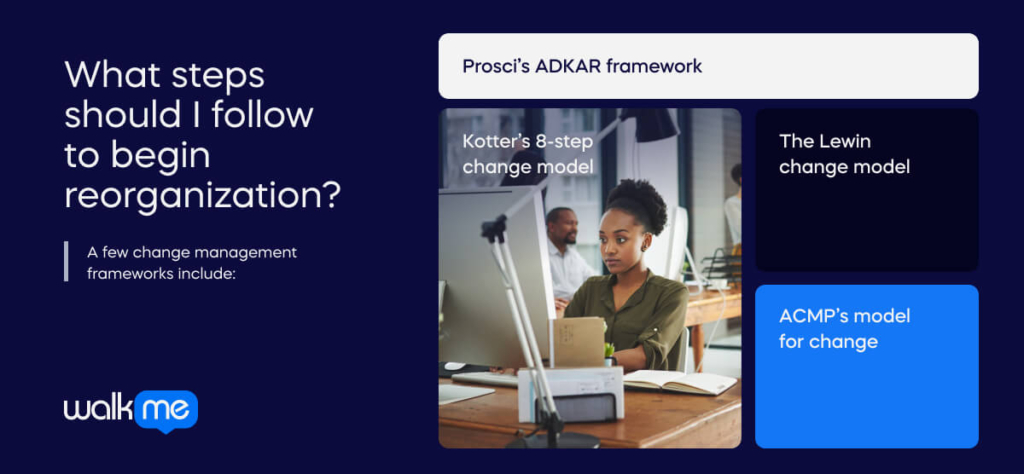What is corporate reorganization and when is the right time to restructure your business?
In this guide, we’ll cover the basics of corporate reorganization – what it is, why it’s useful, its challenges, change management best practices, and more.
Frequently Asked Questions (FAQ) About Corporate Reorganization
In business, reorganization usually refers to major changes in the operational structure of a business.
It can also refer to other organizational changes, such as shifts in the company strategy, its mission, its business model, and so forth.
While these types of changes are often difficult and challenging, reorganization is sometimes necessary for a business to keep up with external or internal challenges.
Why do companies reorganize?
The drivers of reorganization can include, but are not limited to:
- Digital disruption
- Crises such as COVID-19
- Hypergrowth competitors
- Key employees leaving the organization
- Major changes in customer behavior
Problems such as these, in other words, are often the key problem a reorganization attempts to solve.
The biggest benefit to reorganization, therefore, often revolve around solving that problem. A company that reorganizes to keep up with the digital economy, for instance, would ideally wind up becoming more digitally mature.
Aside from solving whatever problem drove them to reorganize, there are several other benefits to reorganization, including:
- Better organizational communication
- Improved organizational efficiency and performance
- Greater alignment between the business and its customers
- An improved organizational culture
Of course, all of these benefits are only possible when the organizational restructuring is carried out effectively. As we’ll see below, this often requires taking a structured approach to change management.
What changes are involved with reorganization?
Reorganization is often used interchangeably with restructuring.
This type of organizational change usually revolve around changes to the company’s organizational chart – that is, its hierarchy. Changes may occur to team structures, management, and even the C-suite.
Yet during major reorganizations, these types of changes are usually accompanied by other business changes.
These additional changes may affect:
- The organization’s mission
- Operating models and business models
- The organizational culture
- A company’s digital strategy
In short, any changes that help the company solve its primary problem may be included as part of the reorganization. The more changes that are included as part of the transformation, however, the more challenging it will be.
What are the challenges of reorganization?

As with any other organizational change, reorganization comes with a set of obstacles that must be navigated. Failing to navigate those obstacles can negatively impact the outcomes of the change project or, in a worst case scenario, cause the change project to fail entirely.
Here are some common challenges associated with organizational changes such as reorganization:
- Resistance to change
- Digital adoption
- Obtaining executive buy-in
- Effective communication
- A lack of key skills
- Unclear expectations
- Maintaining momentum
- Reverting to old behaviors post-project
Every organizational change is unique and must be managed carefully to overcome and mitigate these types of risks. Learning important change management theories is a good first step toward reducing change risks.
What are the alternatives to reorganization?
Reorganization is only one of several types of organizational change.
Others include:
- Organizational culture change
- Changes to the company’s digital strategy
- Business process changes
- Redesigning individual business units
- Changing the business strategy
It is important to note that these types of changes are rarely isolated – one type of organizational change typically goes hand-in-hand with another.
What steps should I follow to begin reorganization?

Change management frameworks offer a good starting point for understanding how to approach organizational change.
These frameworks offer practical, step-by-step roadmaps for designing and implementing change. They also address most of the common obstacles associated with change, such as employee resistance.
A few change management frameworks include:
- Prosci’s ADKAR framework
- Kotter’s 8-step change model
- The Lewin change model
- ACMP’s model for change
These types of frameworks offer good general approach to change management, though the focus is not specifically on restructuring. Reorganization, however, can fit into these general frameworks with a bit of adjustment, making them very useful study material.
What are a few tips and tactics for successful reorganization?
Here are a few points to keep in mind when initiating a reorganization:
- Communication is key to any successful change, since a failure to change can create resistance, errors, and inefficiencies
- Commitment and buy-in from a large number of people, particularly leaders, will be essential for such a dramatic change to succeed
- Staying agile is crucial, since circumstances will often present unforeseen challenges that must be adjusted to on the fly
- Clear designation of new roles and responsibilities is absolutely essential, since the new roles will take getting used to
- Collaborating closely with stakeholders at all levels of the organization can both reduce resistance and generate new ideas for the restructuring process

